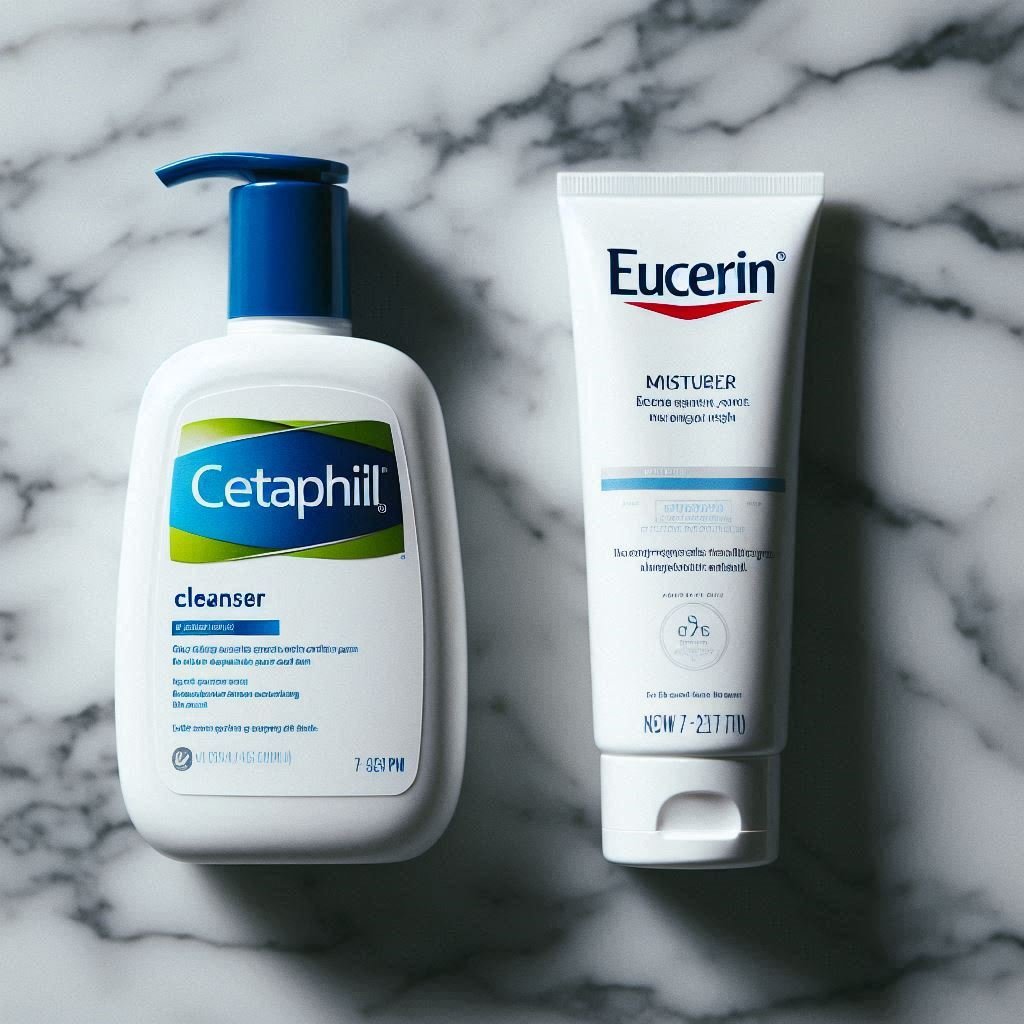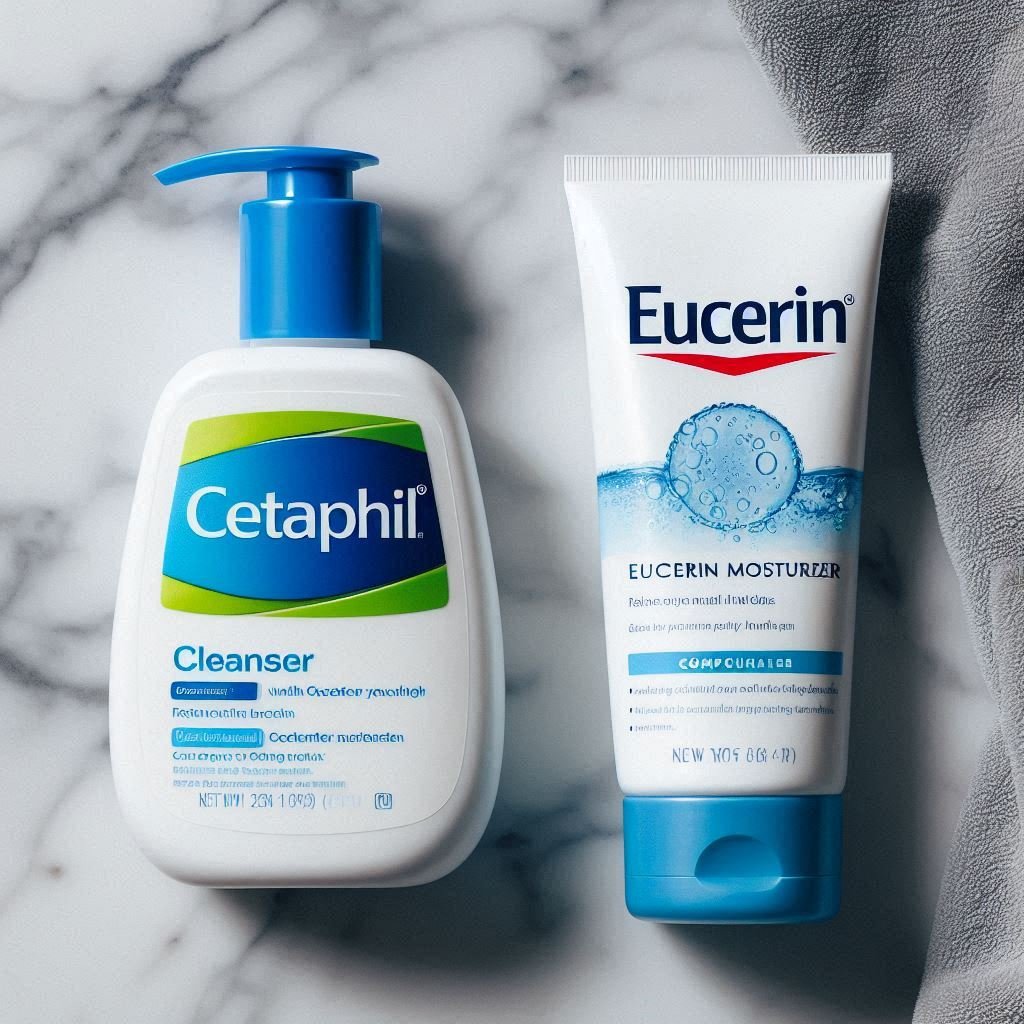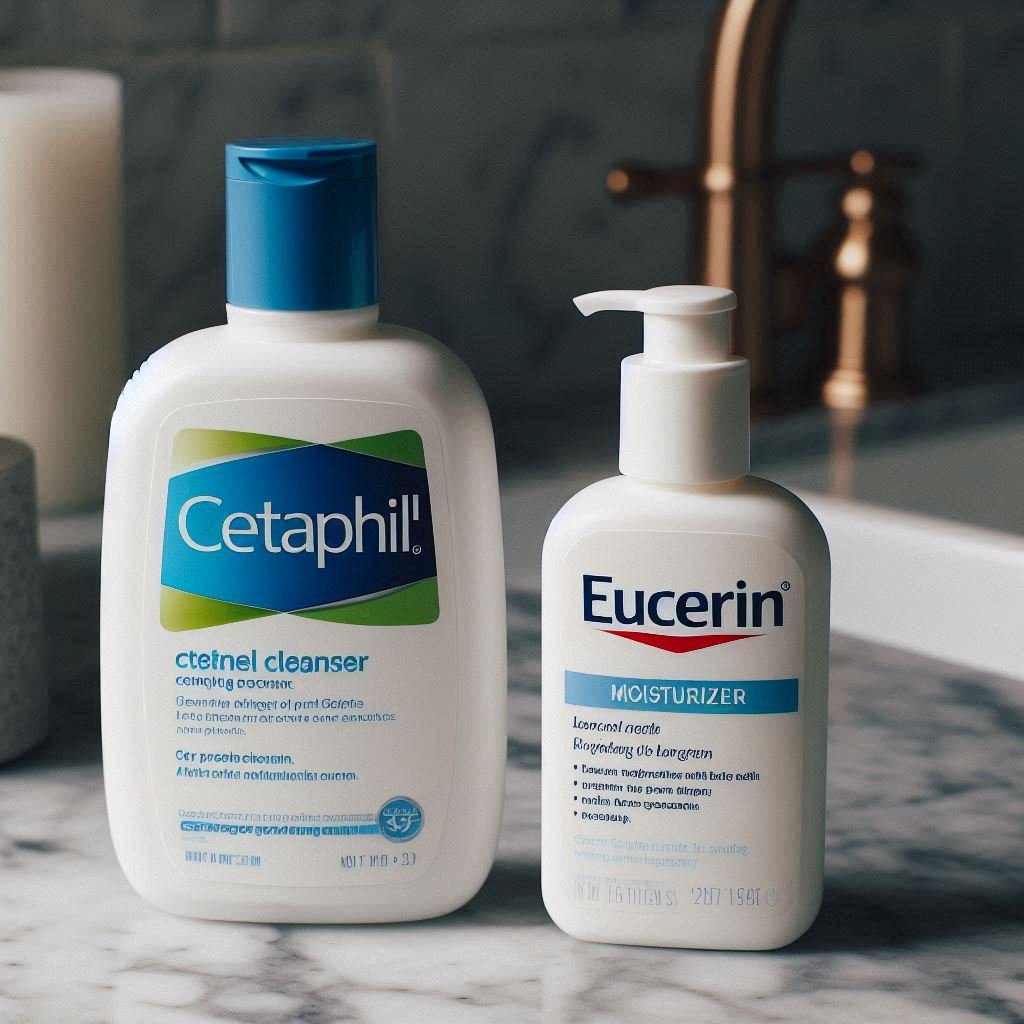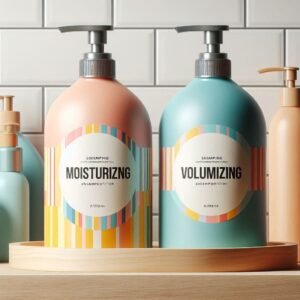Cetaphil Vs Eucerin 2024 – As you navigate the crowded skincare market, you’re likely to come across two familiar names: Cetaphil and Eucerin. Both brands have built a reputation for delivering effective skincare solutions, but which one is right for you? You might be drawn to Cetaphil’s gentle approach or Eucerin’s commitment to scientific innovation.
But before you make a decision, crucially, you need to understand what sets them apart. From their brand philosophies to their product ranges and formulations, there’s more to weigh up than you might think. What will you discover when you take a closer look at these two skincare giants?
A Quick Overview
- Cetaphil focuses on gentle, non-comedogenic products for everyday use, while Eucerin offers a broader range of products for specific skin concerns.
- Eucerin’s products often have a higher concentration of active ingredients and advanced delivery systems, whereas Cetaphil prioritizes gentle, moisturizer bases.
- Cetaphil is generally more suitable for dry skin, while Eucerin is preferred by those with oily complexions due to its non-comedogenic and oil-free formulas.
- Both brands offer fragrance-free options, which are essential for calming sensitive skin and reducing irritation triggers.
- Eucerin’s products are often more expensive than Cetaphil’s, with prices ranging from $10 to over $30, depending on the product and size.
Brand History and Philosophy

Cetaphil and Eucerin, two prominent skincare brands, have distinct brand histories and philosophies that shape their product offerings and customer relationships.
You’ll notice that Cetaphil‘s brand evolution is rooted in its founding by a pharmacist in 1947, focusing on gentle, effective skincare for sensitive skin.
This heritage is reflected in their corporate values, which prioritize dermatologist-recommended products and customer trust.
On the other hand, Eucerin’s history dates back to 1900 in Germany, with a strong emphasis on scientific research and innovation.
Their corporate values center around providing high-quality, evidence-based skincare products that cater to various skin needs.
Understanding these brand philosophies helps you appreciate their unique approaches to skincare and how they engage with customers.
Product Range Comparison

When exploring the product ranges of these two brands, you’ll find that Eucerin offers a more extensive and diverse portfolio, encompassing a broader spectrum of skin care concerns and needs.
This is evident in their product offerings, which cater to specific skin types, such as dry, sensitive, and acne-prone skin.
In contrast, Cetaphil’s brand portfolio, while still thorough, focuses more on gentle, non-comedogenic products suitable for everyday use.
Eucerin’s range includes specialized lines for anti-aging, sun protection, and baby care, demonstrating a more nuanced understanding of the complexities of skin care.
Moisturizer Formulations
You’ll notice distinct differences in the moisturizer formulations of these two brands, with Eucerin often incorporating a higher concentration of active ingredients and advanced delivery systems to address specific skin concerns.
Cetaphil, on the other hand, focuses on gentle, non-comedogenic moisturizer bases that won’t clog pores.
Eucerin’s emollient blends are designed to repair and lock in moisture, whereas Cetaphil’s moisturizers tend to have a lighter, more watery consistency.
This difference in formulation approach is reflected in the texture and feel of the products on your skin.
If you have dry or sensitive skin, you may prefer Eucerin’s richer, more intense moisturizers.
However, if you’re looking for a lightweight, everyday moisturizer, Cetaphil might be the better choice.
Cleanser Ingredients Breakdown
Both brands’ cleanser formulas exhibit distinct variations in their ingredient profiles, with Eucerin often featuring a more exhaustive blend of surfactants, emollients, and humectants.
As you dig into the ingredient lists, you’ll notice Eucerin’s cleansers typically contain a higher number of surfactants, which play a vital role in reducing the surface tension of water to effectively remove dirt and impurities.
Additionally, Eucerin’s formulas often have a more neutral pH level, ranging from 5.5 to 6.5, which is closer to the skin’s natural pH.
This can help maintain the skin’s natural barrier function.
In contrast, Cetaphil’s cleansers tend to have a simpler ingredient profile with a focus on gentle, non-comedogenic ingredients.
Skin Type Suitability
Understanding the ingredient profiles of Cetaphil and Eucerin cleansers is crucial in determining their suitability for specific skin types, as their formulations cater to different skin concerns and needs.
You’ll find that Cetaphil is generally more suitable for dry skin, as it’s formulated with moisturizing ingredients that help lock in hydration.
On the other hand, Eucerin is often preferred by those with oily complexions, as its non-comedogenic and oil-free formula won’t clog pores or exacerbate oiliness.
If you have dry skin, Cetaphil’s gentle, non-irritating cleansers will help soothe and hydrate your skin.
Meanwhile, Eucerin’s lightweight, oil-controlling cleansers will help balance your oily skin.
Acne Treatment Options
When it comes to tackling acne, Cetaphil and Eucerin offer distinct approaches that cater to different acne concerns and skin types.
You may find that Cetaphil’s gentle, non-comedogenic products are better suited for sensitive skin prone to adult acne. These products won’t clog pores, reducing the likelihood of acne triggers like blackheads and whiteheads.
On the other hand, Eucerin’s acne-fighting products contain salicylic acid, which helps to unclog pores and reduce inflammation. If you have more severe acne, Eucerin’s products might be a better fit.
Ultimately, determining your specific acne concerns and skin type is crucial to choose the right treatment approach. By understanding the unique strengths of each brand, you can make an informed decision to effectively tackle your acne.
Anti-Aging Solutions
When it comes to anti-aging solutions, you’re likely looking for products that can effectively reduce wrinkles, treat fine lines, and promote skin renewal.
Both Cetaphil and Eucerin offer a range of products that claim to address these concerns, but how do they stack up?
Let’s examine the specific methods and ingredients each brand uses to combat signs of aging, and explore which one might be the better choice for your skin.
Wrinkle Reduction Methods
You can combat signs of aging with wrinkle reduction methods, including topical treatments, chemical peels, and more, all designed to visibly smooth out fine lines and wrinkles.
When it comes to non-invasive approaches, facial yoga can be a great addition to your skincare routine.
This technique involves gentle exercises that target specific facial muscles, helping to relax and lift the skin.
For more dramatic results, you may consider botulinum toxins, such as Botox or Dysport, which temporarily relax facial muscles to reduce wrinkles.
These treatments can be used in combination with other methods to achieve a smoother, more youthful appearance.
Fine Line Treatment
As you explore ways to combat signs of aging, fine line treatment becomes a key aspect of your anti-aging solutions, offering a range of options to address these subtle yet noticeable imperfections.
Fine lines and wrinkles can be effectively treated with micro needling treatments, which stimulate collagen production to plump up the skin and reduce their appearance.
You can also incorporate facial yoga routines into your daily skincare regimen to relax facial muscles and reduce the formation of fine lines.
By combining these treatments with a consistent skincare routine, you can achieve a smoother, more youthful appearance.
Skin Renewal Process
Through a thorough skin renewal process, incorporating anti-aging solutions can help stimulate cellular turnover, reducing the appearance of fine lines and wrinkles.
As you incorporate these solutions into your routine, you’ll notice an improvement in skin texture and tone.
This is because cell turnover is accelerated, allowing for the removal of dead skin cells and promoting the growth of new, healthy ones.
Regular skin exfoliation is a vital step in this process, helping to unclog pores and remove impurities.
By combining these methods, you’ll be on your way to achieving a smoother, more radiant complexion.
Sensitive Skin Care
When you’re dealing with sensitive skin, finding the right products can be a game-changer.
You need solutions that soothe skin irritation, employ gentle cleansing methods, and offer hypoallergenic options to minimize reactions.
As you explore Cetaphil and Eucerin, you’ll want to examine how these brands address these specific concerns to guarantee you’re getting the care your sensitive skin deserves.
Soothing Skin Irritation
You can find relief from skin irritation with gentle, fragrance-free products that calm and comfort sensitive skin.
When calming redness, it is vital to identify and avoid common irritation triggers, such as harsh soaps, exfoliating scrubs, or extreme temperatures.
Fragrances, dyes, and artificial ingredients can also exacerbate skin irritation, so it is imperative to opt for products labeled ‘fragrance-free’ or ‘hypoallergenic.’
Additionally, look for products containing soothing ingredients like aloe vera, chamomile, or green tea, which can help reduce inflammation and discomfort.
Gentle Cleansing Methods
To maintain healthy, irritation-free skin, adopting gentle cleansing methods that respect your skin’s natural barrier function is vital.
You should opt for soap-free alternatives that won’t strip your skin of its natural oils. Instead, choose fragrance-free options that are less likely to trigger allergic reactions or irritation.
When cleansing, use lukewarm water and a gentle massaging motion to remove dirt and impurities. Avoid harsh exfoliants and rough cloths, which can further disrupt your skin’s delicate balance.
Hypoallergenic Product Options
Hypoallergenic products, specifically designed for sensitive skin care, offer a lifeline for individuals struggling with skin irritation, providing a range of gentle, non-irritating options that cater to their unique needs.
As you navigate the world of sensitive skin care, you’ll want to opt for products that minimize the risk of skin reactions. You can breathe a sigh of relief knowing that hypoallergenic products are formulated to reduce allergy triggers and alleviate discomfort.
Some key benefits to look for in hypoallergenic products:
- Fragrance-free and odorless formulas to minimize irritation
- Gentle, non-comedogenic ingredients that won’t clog pores
- Soothing agents like aloe vera or chamomile to calm the skin
- Rigorous testing to guarantee products are free from common allergens
Eczema and Dermatitis Support
When managing eczema and dermatitis, using the right moisturizer can help alleviate symptoms and prevent flare-ups.
You know how frustrating it can be to deal with itchy, dry skin, but finding the right product can make all the difference.
Eucerin’s moisturizers are specifically designed to combat eczema triggers, such as dry air and harsh soaps, which can lead to skin flare-ups.
Their rich, non-greasy formulas lock in moisture, reducing inflammation and discomfort.
By using Eucerin’s products, you can create a protective barrier on your skin, shielding it from irritants and promoting a healthy, balanced skin environment.
With Eucerin, you can finally find relief from the discomfort and embarrassment of eczema and dermatitis, and start feeling confident in your own skin.
Pricing and Availability
Eucerin’s eczema-friendly moisturizers can be found at various online retailers, pharmacies, and dermatologist offices, with prices ranging from around $10 to over $30, depending on the product and size.
When it comes to purchasing Eucerin products, you have several options to explore.
Check online marketplaces like Amazon for discount options and free shipping deals.
Visit Eucerin’s official website to find authorized retailers and store locations near you.
Look for in-store promotions and loyalty programs at pharmacies like CVS or Walgreens.
Ask your dermatologist about sample products or special offers during your next appointment.
User Reviews and Ratings
As you explore the user reviews and ratings of Cetaphil and Eucerin, you’ll notice that a thorough analysis of the rating breakdown can reveal valuable insights into the strengths and weaknesses of each brand.
By examining the data, you’ll be able to identify patterns and trends that can inform your decision-making process.
Next, let’s take a closer look at the user experience insights that emerge from these ratings.
Rating Breakdown Analysis
Cetaphil and Eucerin’s user reviews and ratings are analyzed to provide an exhaustive rating breakdown, revealing significant differences in customer satisfaction between the two brands.
As you delve into the data, you’ll notice that Cetaphil scores higher with respect to rating consistency, with an average rating of 4.5 out of 5 across various platforms.
Eucerin, on the other hand, has a more scattered rating distribution, with some products receiving high praise while others fall short.
Cetaphil’s products have higher overall ratings, with 80% of reviewers giving 4- or 5-star reviews.
Eucerin’s products have more varied ratings, with 60% of reviewers giving 4- or 5-star reviews.
Cetaphil is more transparent about its ingredients, which may contribute to its higher ratings.
Eucerin’s ratings are more inconsistent across different product lines.
User Experience Insights
Delving into user reviews and ratings reveals a wealth of information about the experiences of individuals who’ve used Cetaphil and Eucerin products.
You’ll find that users praise Cetaphil for its gentle, non-irritating formula that seamlessly fits into daily routines. Many appreciate its fragrance-free and hypoallergenic properties, which cater to various skin types.
On the other hand, Eucerin users rave about its rich, nourishing textures that address specific skin concerns. You’ll notice that personal preferences play a significant role in user experiences, with some preferring Cetaphil’s lightweight feel and others enjoying Eucerin’s intense moisturizing benefits.
Key Differences and Recommendations
You’ll likely find that the most significant difference between Cetaphil and Eucerin lies in their formulations and target skin types. Cetaphil is generally geared towards sensitive skin, while Eucerin caters to dry and very dry skin.
When choosing between the two, consider your skin type and specific needs.
Cetaphil is ideal for: Sensitive skin, gentle cleansing, and non-comedogenic properties.
Eucerin is ideal for: Dry and very dry skin, intense moisturizing, and repairing the skin’s natural barrier.
Both brands offer: Fragrance-free and hypoallergenic options, making them suitable for sensitive skin.
Ultimately, choose: The brand that aligns with your skin type and specific needs for peak results.
Frequently Asked Questions
Can I Use Cetaphil and Eucerin Products With Makeup and Sunscreen?
You can definitely use Cetaphil and Eucerin products with makeup and sunscreen in your morning routine and nighttime regimen; just apply them in the right order to maximize their benefits and guarantee a smooth, protected complexion.
Are Cetaphil and Eucerin Products Cruelty-Free and Vegan-Friendly?
You wonder if Cetaphil and Eucerin are cruelty-free and vegan-friendly, and it’s great that you care! Both brands have animal testing policies in place, but Eucerin holds cruelty-free certifications like PETA, while Cetaphil doesn’t, making Eucerin a better choice for you.
Can I Use Cetaphil and Eucerin Products on My Baby’s Skin?
You can use Cetaphil and Eucerin products on your baby’s skin, but be cautious with sensitive skin types, as they may trigger reactions; always patch test and consult a pediatrician before introducing new products to their delicate skin.
Do Cetaphil and Eucerin Products Expire, and How Do I Store Them?
You should check the product labels for expiration dates, as they vary. Typically, Cetaphil and Eucerin products last 2-3 years unopened. Store them in a cool, dry place with a consistent storage temperature below 77°F (25°C) to maintain their product shelf life.
Can I Use Cetaphil and Eucerin Products if I Have Rosacea or Redness?
When managing rosacea or redness, you’ll want to approach skincare with caution. If you have sensitive skin, look for fragrance-free, gentle products that won’t trigger redness, and patch test before using Cetaphil or Eucerin products to confirm tolerance.
Conclusion
You’ve now got a thorough understanding of the similarities and differences between Cetaphil and Eucerin.
Both brands offer unique strengths, with Cetaphil exceling in gentle, fragrance-free products for sensitive skin and Eucerin providing innovative, research-driven solutions for various skin concerns.
Ultimately, your skin type and specific needs will dictate which brand is best for you.
Consider your priorities and choose the products that align with your skincare goals.



